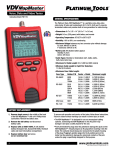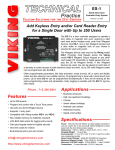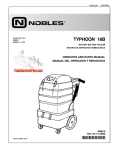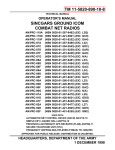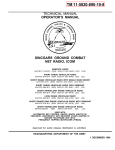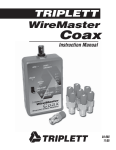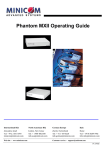Download Platinum T129K1 cable network tester
Transcript
® Voice, Data, Video + Length Instruction Sheet: P/N T129 GENERAL SPECIFICATIONS The Platinum Tools, VDV MapMaster2.0™ is a portable voice-data-video cable tester with length measurement. It tests and troubleshoots RJ11, RJ12, RJ45 and F-conector terminated cables and provides built-in tone generation for cable tracing. •Dimensions: 6.4˝ x 2.8˝ x 1.4˝ (16.3 x 7.1 x 3.6 cm) •Weight: 9.0 oz. (256 grams) with battery and remote •Operating Temperature: 0˚C/32˚F to 50˚C/122˚F •Storage Temperature: -20˚/-4˚F to 60˚C/140˚F •Humidity: 10% to 90%, non-condensing •Maximum Voltage between any two connector pins without damage: RJ Jack: 66V DC or 55V AC F-Connector: 50V DC or AC •Battery Life: 9V alkaline battery typical Standby: 4 years Active: 425 hours •Cable Types: Shielded or Unshielded; Cat7, Cat6x, Cat5e, Cat5, Cat4, Cat3, Coax •Maximum RJ Cable Length: 0 to 1,000 feet (305 meters) •Minimum Cable Length for Split Pair Detection: 1.5 feet (0.5 meters) •Low Battery: Icon flashes when battery voltage falls below 6V •Measurement Technology: Capacitance testing •Length Accuracy Without Length Constant Accuracy: ± 3% plus ± 1 foot •Cable Length Measurement: 1 to 2,000 ft CAT5E cable with 15 pF/ft length constant •Default Length Constant: Restored with power on reset • Voice: 17.4 pF/ft • Video: 16.5 pF/ft • Data: 15 pF/ft Complies with Conformité Européenne directives. •Maximum Coax Cable Length: Coax Type Belden P/N Center + Shield Maximum Length RG-58A/U RG-59/U RG-6/U Mini Coax RG-11/U 8259 9311 7806A 9310 9259 8241A 9275 9659 1694A 1152A 9221 1523A 14.9Ω / 1,000 ft 25.8Ω / 1,000ft 11.8Ω / 1,000ft 24.1Ω / 1,000ft 23.5Ω / 1,000ft 49.7Ω / 1,000ft 78.5Ω / 1,000 17.6Ω / 1,000ft 7.2Ω / 1,000ft 29.8Ω / 1,000ft 111Ω / 1,000ft 15.1Ω / 1,000ft 6,710ft (2,045m) 3,876ft (1,182m) 8,475ft (2,583m) 4,150ft (1,265m) 4,255ft (1,297m) 2,010ft (613m) 1,275ft (389m) 5,682ft (1,732m) 13,889ft (4,234m) 3,360ft (1,025m) 900ft (275m) 6,623ft (2,019m) BATTERY REPLACEMENT WARNINGS 1) Remove single screw in the middle of the back of the VDV MapMaster2.0™ with a #1 Phillips head screwdriver. Remove the battery door. To ensure safe operation and service of the tester, follow these instructions. Failure to observe these warnings can result in severe injury or death. 2) Remove the old battery and disconnect battery cable. 3) Replace with an ANSI 1604A, 9 volt alkaline battery (Energizer 522, Duracell Mn1604). Reattach cable and insert into battery compartment. 4) Replace battery door and screw. DO NOT OVERTIGHTEN! 1 •The VDV MapMaster2.0™ is designed for use on unenergized cabling systems. Connecting the VDV MapMaster2.0 to live AC power may damage it and pose a safety hazard for the user. •Poorly terminated RJ plugs have the potential to damage the jacks on the VDV MapMaster2.0™. Visually inspect an RJ plug before inserting it into the tester. The contacts should always be recessed into the plastic housing of the plug. Plugging 6-position plugs into the 8-position jack on the tester has the potential to damage the outermost contacts of the jack unless the plug is specifically designed for that purpose. www.platinumtools.com ©2012 Platinum Tools Inc. All rights reserved. 5/12 over miswires and the appropriate icon(s) illuminates. The “Split” icon illuminates if the designated pairs are not twisted together in the cable, an AC signal fault. DISPLAY 1 2 3 4 5 6 4) Shield: “Shielded” illuminates when a shielded data cable is properly connected at both ends. It will be flashing if there is a short to a wire in the cable along with that pin number and the “Short” indicator. 7 5) Tester-End Wire Map: The top line displays the pins on the tester end in order. These pins are mapped to the pins on the remote-end shown directly below them on the LCD. 8 9 6) Remote-End Wire Map: The bottom line displays the corresponding pin on the remote-end. Dash lines on the remote line indicate short pins. No pin numbers displayed on the remote line are open pairs. 7) Battery Low: The battery low symbol illuminates when the battery is nearing depletion. The symbol will begin to flash when the battery needs to be replaced. Results may be unreliable at this point. 1) Mode: The top line displays the cable type test mode or tone generation mode. 2) Pass/Special Cables: “Pass” will be on if the cable is a properly wired 4-pair T568A/B data cable, a 3-pair one-to-one wired voice cable or a video cable with no faults. In addition, “X-over” illuminates if a properly wired cross-over (uplink) cable is recognized or the “Rev” illuminates if the cable is a properly wired reverse-pinned voice cable. The wire map will show actual pin connections. 8) Location ID: In the video or the ID modes, the “ID” icon will be on with the number of the remote ID displayed or an error message of “Open” or “Short”. 9) 3) Cable Faults: The “Fail” icon will be on only if the cable is not wired to one of the cabling standards. An open or short error takes precedence A B C Length Mode: When the LENGTH/TONE button is pressed, the measured cable length (in units of feet or meters) appears in the lower right corner of the LCD display screen and the “L” icon appears above pins 7 and 8 in the Wire Map. The following values and icons display in the screen when measuring cable length: •Edit Capacitance: A long press (two seconds) of the button allows you to edit the length constant When adjusting the length constant value for a cable, the “Edit Cap” icon appears in the bottom of the screen. An “E” icon \ displays above pins 7 and 8 in the Wire Map to indicate you are in Edit Mode. •Length Constant Value: A value, measured in picofarads (pF) per foot or meter appears in the bottom of the LCD display screen. This value corre sponds to the selected cable type and can be adjusted at any time. When viewing the length constant value for a cable type, the “C” icon displays above pins 7 and 8. KEYPAD D E A) Voice: Each press of the Voice button causes one test to be run on the 6-position RJ jack and the results displayed. The VDV MapMaster2.0™ will turn off after 20 seconds automatically. If the button is pressed and held until “LOOP ON” is displayed, tests are run continuously and the display updated until the O/ID button is pressed or after 5 minutes of no change in results. Continuous mode is useful for trouble-shooting intermittent problems. •In Length Mode, the yellow arrow allows you to adjust the length constant value. •A short press of the Voice and Video buttons simultaneously changes the length measurement unit from feet to meters. B) Video: Pressing the Video button starts the ID test, testing only for the F-connector, because the video continuity test is the same as the ID test. The test loops continuously until the O/ID button is pressed or for 5 minutes after the last change in ID status. •In Length Mode, the yellow arrow allows you to adjust the length constant value. •A short press of the Voice and Video buttons simultaneously changes the length measurement unit from feet to meters. E) Off/ID (O/ID): Pressing O/ID will turn off the VDV MapMaster2.0™ when it is on in any mode. With the VDV MapMaster2.0™ off, pressing the O/ID button starts the ID test mode. The ID test mode scans for all possible ID types – voice, video and data. The “ID” icon and a progression of “o” are displayed on the bottom line of the display to indicate scanning is active. If no ID remotes are found, “Open” is displayed. When and ID remote is found, the connector type and the ID number are displayed. If multiple ID remotes are found, the ID or fault is displayed in sequence. The test loops continuously until the I/OD button is pressed or for 5 minutes after last change in ID status. The RJ jacks share internal connections so only one RJ cable can be NOTE C) Data: Each press of the Data button causes one test to be run on the 8-position RJ jack and the results displayed. The VDV MapMaster2.0™ will turn off after 15 seconds automatically. If the button is pressed and held until “LOOP ON” is displayed, tests are run continuously and the display updated until the O/ID button is pressed or after 5 minutes of no change in results. Continuous mode is useful for finding intermittent problems. D) Length/Tone: Tone Mode: When tone is pressed; the VDV MapMaster2.0™ begins sending an audio tone for the connector last tested with the pins and cadence previously selected for that connector type. To change the connector type, press a different connector type button. Pressing the same connector type button again, will change the pins carrying the tone. Pressing the Tone button will cycle through the available tone cadences. To turn the VDV MapMaster2.0™ off, press the O/ID button. The VDV MapMaster2.0™ will turn off automatically 60 minutes after the last button press. The tone is compatible with analog tone tracers. 2 Voltage Detected Warning: If voltage is detected on any of the tester connectors, the “Voltage!” icon is turned on. A check for voltage is performed before each test and if found, no test is run. The tester should be disconnected immediately from the source of the voltage. connected at a time for accurate cable test results. However, an RJ cable and a coax cable may be connected at the same time. In ID mode, all connectors on the VDV MapMaster2.0™ may be connected at the same time. ID/MAPPING ID/Mapping: Pressing the O/ID button starts the ID test mode on the VDV MapMaster2.0™. Review section “E” under category “KEYPAD”. ID/MAP up to 19 locations at one time with numbered custom ID remotes, whether Voice (RJ12/11), Video (coax) or Data (RJ45). Place ID remotes at one end, the VDV MapMaster2.0™ at the other end and start scanning. Mode Locator ID # www.platinumtools.com ©2012 Platinum Tools Inc. All rights reserved. 5/12 WIRING and DISPLAY EXAMPLES Properly Wired T568A UTP: T568A Cable with Split Pairs: 1 2 3 4 5 6 7 8 Properly Wired T568A UTP: T568B is electrically identical to T568A, but swaps the green and orange pairs. Either standard will work as long as the same standard is used at both ends of a run or patch cable. Mixing “A” and “B” creates a cross-over cable. 1 2 3 4 5 6 7 8 T568A Cable with Split Pairs: A common error in building a cable is to put all the pairs in pin sequence 1-2, 3-4, 5-6 and 7-8. This will produce the correct continuity, but the pairs are designated to be on pins 3-6 and 4-5 in the middle of the connector for compatibility with phone wiring. This wiring error is only detected by the split pair test since the designated pairs are not twisted together. 8 1 8 = FLASHING 1 T568A Cable with a Short and Open: 1 2 3 4 5 6 7 8 X T568A Cable with a Miswire and Unrecognized Continuity: 1 2 3 4 5 6 7 8 T568A Cable with a Short and an Open: The 1-2 pair pins are shorted together and the 7-8 pair is open. The pins with the errors are flashing. Dash lines (-) on the bottom (remote) display line indicate the short, while no numbers on the bottom line indicate the open pair. 3 1 2 3 4 5 6 7 8 1 2 3 4 5 6 7 8 T568A Cable with a Miswire and unrecognized Continuity: 1 and 2 pins on the VDV MapMaster2.0™ are connected to pins 2 and 1 at the remote-end. The pins with this error are flashing. The “U” for the remote pin numbers indicates an unrecognizable continuity was detected that is neither a short or open. An ID remote connected to the VDV MapMaster2.0™ when in cable test mode would also show this error. www.platinumtools.com ©2012 Platinum Tools Inc. All rights reserved. 5/12 USING LENGTH MODE Measure Cable Length: Measures the entire length of a cable as well as the length of individual wire pair. NOTE: Using Coax or Network wire mapping remotes while measuring length will add one to two feet to the length reading due to internal stray capacitance. 1) Make sure the power is turned OFF. 2) Insert the cable plug into the corresponding receiver on the main tester (RJ11 jack for voice cables, RJ45 jack for data cables, F-Connector for video cables). 3) Press the LENGTH/TONE button to enter Length Mode. The following icons appear in the display screen to the right. •An “L” icon appears in the right side of the screen. •Cable length in units of feet or meters displays in the bottom of the screen. •The connector type last selected (voice, data, or video) displays in the top of the screen. •An “o” symbol bounces in the lower left corner of the screen to indicate activity. NOTE: Measuring cable length is the primary function of the LENGTH/TONE button. If you hold down the button too long, you will enter Tone Mode. If you mistakenly enter Tone Mode, simply press the O/ID button and select the LENGTH/TONE button again to enter Length Mode. 4) Change measurement units. The units can be changed from feet to meters and back again by quickly pressing the VOICE and VIDEO buttons at the same time. When the unit of measurement is set to feet, the “ft” icon is displayed in the lower right corner of the screen. When meters are selected, the unit of measurement is not displayed. 5) Verify the connector type appearing in the display screen matches the connected cable. If it does not match, press the cable type button corresponding to the cable you plan to measure (voice, video, or data). NOTE: If you do not select the cable test mode matching the connected cable, the tester will try to measure the previously tested cable and may skew the measured length results. 6) Measure Entire Cable: After selecting the cable type button for the connected cable, the measured length reading shown in the display screen is representative of the entire cable. NOTE: Voice and Video length modes automatically select and display the length of the first pin pair without a fault. For cables with no faults, the length of pair 1-2 for Data Mode and pair 3-4 for Voice Mode will automatically appear in the display screen. The Tester Pin # field is blank when the length reading for the entire cable is displayed. Refer to Step 7 below for instructions on stepping through the wire pairs. Refer to the LCD Display Screen section for a description of the Tester Pin # field. 4 7) Measure Pin Pairs: Press the cable type button again to measure the length of the first pin pair. The number(s) for the pair being measured will display in the screen (see Figure 14). Subsequent presses of the cable type button will cycle through all the pairs and return to the length reading for the entire cable when you have advanced past the last pin pair. The following icons appear in the display screen below: •The cable type icon appears at the top of the screen. •Length of pin pairs in units of feet or meters displays in lower right corner of the screen. •The “L” icon displays indicating you are in Length Mode. •A bouncing ball activity indicator appears in the lower left corner. NOTE: If the selected cable pair is shorted, “SHORT” will display for the shorted pair and the length readout is dashes. 8) Interpret display results and trouble-shoot potential cable faults. View the Lenght Constant: 1)While in Length Mode, press the LENGTH/TONE button again to view the length constant. The following occurs in the display screen below. •The “L” icon changes to “C” indicating the length constant is being displayed. •The connector type (voice, data, or video) appears in the top of the screen. •The length constant, measured in picofarads per unit length, displays in the bottom of the screen. NOTE: Each press of the LENGTH/TONE button toggles between displaying the measured cable length and the length constant. After a few seconds the display screen defaults back to the measured length. www.platinumtools.com ©2012 Platinum Tools Inc. All rights reserved. 5/12 USING LENGTH MODE (continued) Adjust the Length Constant Value: The VDV MapMaster2.0™ has default length constant values for voice, video, and data cables. These values, shown in Table 8, are common length constants that apply to these cable types. You can adjust the length constant value according to the specifications of the Cable Length Constant cable you are testing. Type (picofarads per ft.) NOTE: Bypass this section if the default Voice 17 pf/ft values (see chart to the right) stored in Data 15 pf/ft the tester’s memory satisfy the length Video 15 pf/ft constant values for the cables you are measuring. NOTE: The length constant value last set for each connector type (voice, video, or data) is stored in the unit’s memory. If you have not adjusted the length constant value for any or all cable types, the default values will be stored. The length constant can be adjusted at any time. 1) When in Length Mode, press and hold the LENGTH/TONE button until “EDIT CAP” appears in the bottom of the display screen. The following updates listed below occur in the display screen: •The selected connector type (voice, data, or video) appears in the top of the screen. •An “E” will display in the right side of the screen to indicate you are in Edit Mode. •The display screen toggles between the current length reading and the length constant value. 2) Adjust the Length Constant value for the cable you are testing. In Edit Mode, the VOICE and VIDEO Mode buttons function as Up and Down (yellow arrows are denoted on the buttons). You can use these buttons to adjust the length constant over a range of 10 to 40 picofarads per foot in 0.1pF/ft increments. NOTE: While editing, the display screen toggles back and forth between the length constant value and the measured cable length. You can edit the length constant value when the length constant is displayed. Continuously pressing the UP or DOWN buttons keeps the length constant on the display screen. Toggling begins when a few seconds have lapsed after the last button press. You can also edit the length constant value while the measured length is displayed in the screen. This is helpful when you know the length of the cable. Press the UP/DOWN buttons while length is displayed in the screen. Continue to adjust the length constant until the reading matches the known cable length. The length constant is being updated as the length display is changing. 3) Select the LENGTH/TONE button again to measure the connected cable under the parameters of the new length constant. NOTE: If the cable’s capacitance is too large, dashes will display for the length. Changing the connector type or exiting Length Mode will store the adjusted length constant in the unit’s memory for the next test. Up to three length constants can be stored, one of each connector type. Length Constant Accuracy: The length constant refers to the electrical parameter used to measure length, in this case, the capacitance of the cable per foot or meter. Accuracy is dependent on how close the instrument can be set to the cable constant for the cable being measured. MASTER REMOTE The VDV MapMaster2.0™ Remote designed for testing both Voice (RJ12/11) and Data (RJ45) networks. Patch cables can be tested without removing the remote from storage. NOTE: extra master remotes can be used simultaneously if mapping is done first so each master remote can be identified. Master Remote used for network testing. ACCESSORIES Additional accessories to help make testing easier. Coax Remote Set P/N T120C ID/MAP 19 video (coax) cables at one time. Numbered custom F remotes 1 thru 19 for easy identification. Data Remote Set P/N T121C ID/MAP 19 data (twisted pair) cables or data ports/ jacks at one time. Numbered custom RJ45 remotes 1 thru 19 for easy identification. Master Remote P/N T124C The replacement Master Remote(s) can be used as an extra Master Remote(s) when testing networks. Map your network first to help identify the extra Master Remote(s). Toner Cable P/N T125C RJ45/Alligator Use when shooting tone via the data port. Cable conductors are terminated on contact #1 and #2, so program your VDV MapMaster to shoot tone on pair 1 and 2. NO-Fault Cable P/N T126C 7.5” Special RJ12 to RJ12 The NO-Fault Cable uses no-fault RJ12 connectors on both ends to assure no damage to the RJ45 jacks. It is the ideal patch cable to use when mapping or shooting tone. RJ45 PortSaver P/N 21025 Extend the life of your tester by using the RJ45 PortSaver as your sacrificial cable. This eliminates the wear and tear from constantly plugging in and out of the tester port. Hanging Pouch P/N 4007 Durable pouch for safe storage and transport of your tester. The length constant can vary from cable to cable, of the same type produced by the same manufacturer. It can also vary over the length of one cable because the length constant is dependent on the physical properties of the cable, which may not be consistent throughout the entire cable. The change in wire pair spacing through the cable can vary the length constant along the length of the cable. 5 www.platinumtools.com ©2012 Platinum Tools Inc. All rights reserved. 5/12





